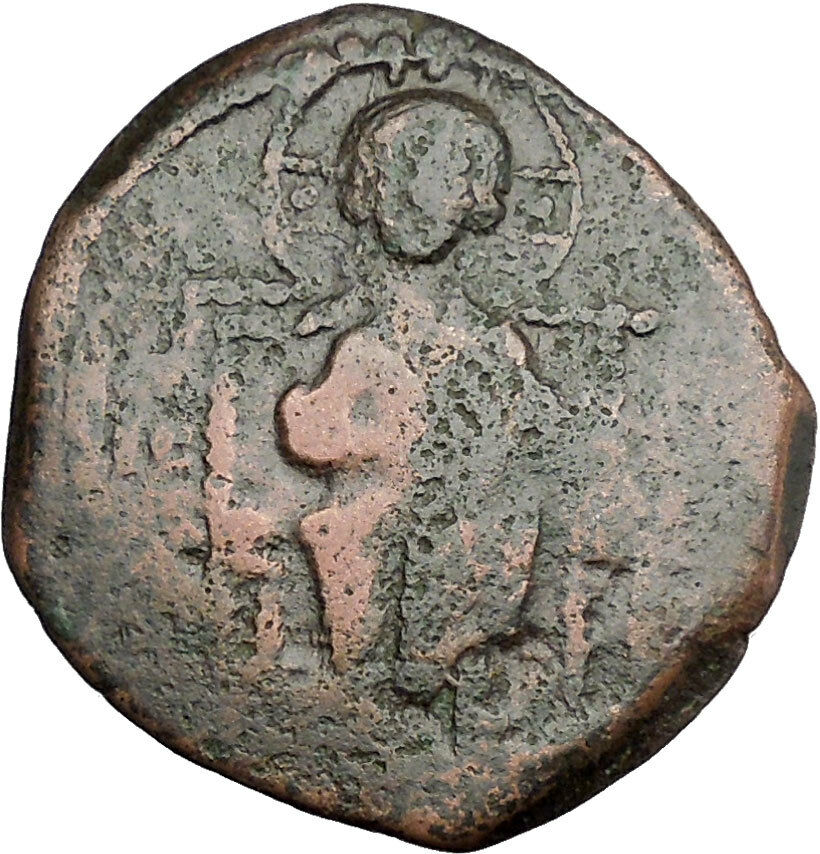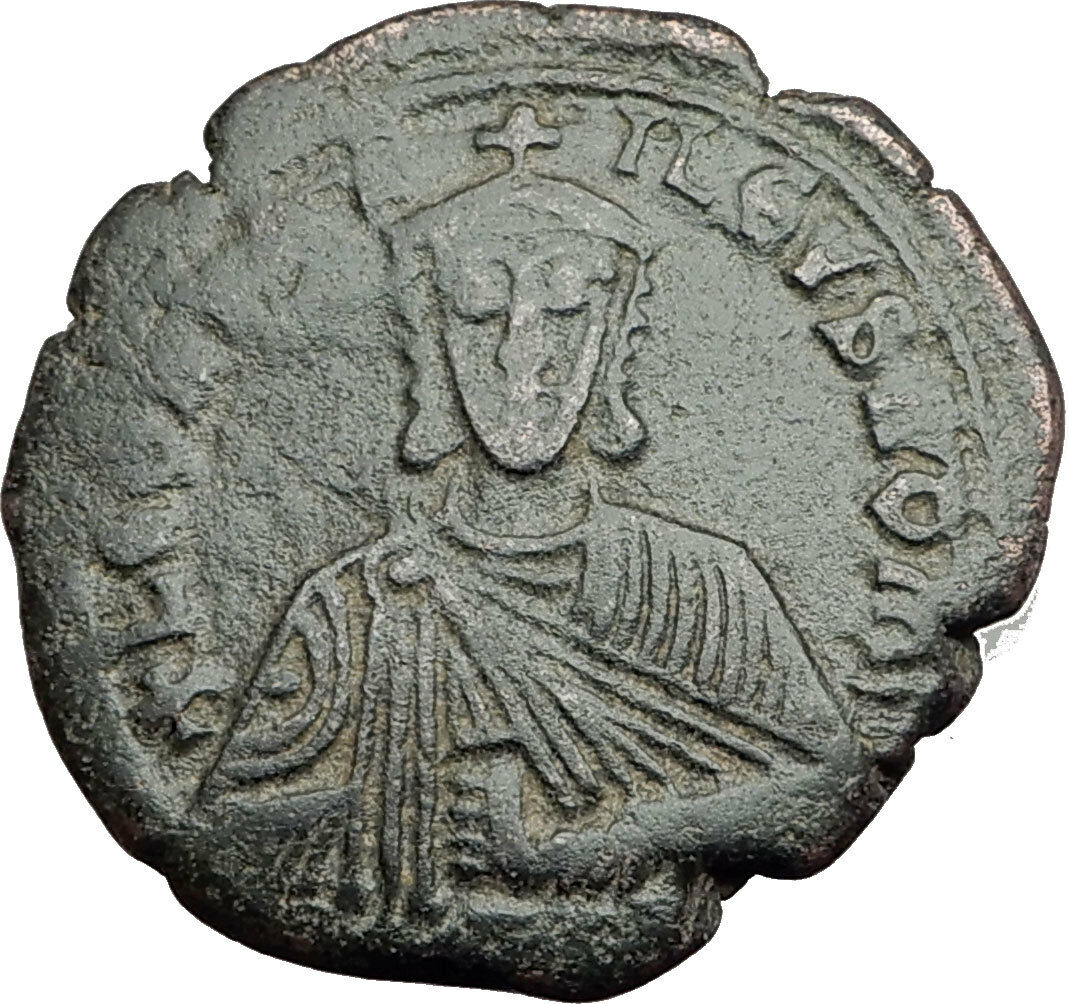|
Byzantine –
Manuel I
, Comnenus – Byzantine Emperor: 8
April 1143 – 24 September 1180 A.D.
Bronze Tetarteron 20mm (3.12 grams) Struck at the mint of Thessalonica
1143-1180 A.D.
Reference: Sear 1975.
Bust of Saint George
Saint George facing, beardless, wearing nimbus, tunic, cuirass and sagion,
and
holding spear and shield; to left, Θ / Γ / Є; to right, WP / ΓI / O / C.
MANYHΛ ΔΕCΠΟΤ, Bust of Manuel facing, wearing crown and loros, and holding
labarum and
globe topped with a cross.
Royal/Imperial symbols of power
Ruling dynasties often exploit pomp and ceremony with the use of
regalia
:
crowns
,
robes,
orb (globe) and sceptres
, some of which are
reflections of formerly practical objects. The use of language mechanisms also
support this differentiation with subjects talking of “the crown” and/or of “the
throne
” rather than referring directly to
personal names and items.
You are bidding on the exact
item pictured, provided with a Certificate of Authenticity and Lifetime
Guarantee of Authenticity.
Comnenus, or Manuel
I Komnenos (Greek:
Μανουήλ Α’ Κομνηνός, Manouēl I
Komnēnos,
November
28
, 1118
–
September 24
,
1180) was a
Byzantine Emperor
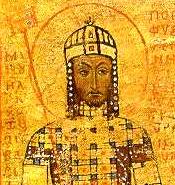 of the 12th century who reigned over a crucial turning of the 12th century who reigned over a crucial turning
point in the history of
Byzantium
and the
Mediterranean
. Eager to restore his
empire
to its past glories as the superpower of the Mediterranean world,
Manuel pursued an energetic and ambitious foreign policy. In the process he made
alliances with the Pope
and the resurgent west, invaded
Italy
, successfully handled the passage of the dangerous
Second Crusade
through his empire, and established a Byzantine protectorate
over the
Crusader kingdoms
of
Outremer
.
Facing Muslim
advances in the
Holy Land
,
he made common cause with the
Kingdom of Jerusalem
and participated in a combined invasion of
Fatimid
Egypt
.
Manuel reshaped the political maps of the
Balkans
and
the east Mediterranean, placing the kingdoms of
Hungary
and Outremer under Byzantine
hegemony
and campaigning aggressively against his neighbours both in the west and in the
east. However, towards the end of his reign Manuel’s achievements in the east
were compromised by a serious defeat at
Myriokephalon
, which in large part resulted from his arrogance in attacking
a well-defended
Seljuk
position.
Called ho Megas (Greek:
ὁ Μέγας, translated as “the
Great“) by the Greeks
, Manuel is known to have inspired intense loyalty in those who served
him. He also appears as the hero of a history written by his secretary,
John
Kinnamos
, in which every virtue is attributed to him. Manuel, who was
influenced by his contact with western Crusaders, enjoyed the reputation of “the
most blessed emperor of
Constantinople
” in parts of the
Latin
world as
well.[1]
Modern historians, however, have been less enthusiastic about him. Some of them
assert that the great power he wielded was not his own personal achievement, but
that of the
dynasty
he represented; they also argue that, since Byzantine imperial power
declined so rapidly after Manuel’s death, it is only natural to look for the
causes of this decline in his reign.

Labarum of Constantine I, displaying the “Chi-Rho” symbol above.
The labarum was a
vexillum
(military standard) that displayed
the “Chi-Rho”
symbol
☧
, formed from the first two
Greek letters
of the word “Christ”
—
Chi
and
Rho
. It was first used by the
Roman emperor
Constantine I
. Since the vexillum consisted of
a flag suspended from the crossbar of a cross, it was ideally suited to
symbolize the
crucifixion
of
Christ
.
Later usage has sometimes regarded the terms “labarum” and “Chi-Rho” as
synonyms. Ancient sources, however, draw an unambiguous distinction between the
two.
Etymology
Beyond its derivation from Latin labarum, the etymology of the word is
unclear. Some derive it from Latin /labāre/ ‘to totter, to waver’ (in the sense
of the “waving” of a flag in the breeze) or laureum [vexillum] (“laurel
standard”). According to the
Real Academia Española
, the related
lábaro
is also derived from Latin labărum
but offers no further derivation from within Latin, as does the Oxford English
Dictionary.[5]
An origin as a loan into Latin from a Celtic language or
Basque
has also been postulated. There is a
traditional Basque symbol called the
lauburu
; though the name is only attested from
the 19th century onwards the motif occurs in engravings dating as early as the
2nd century AD.
Vision of Constantine

A coin of Constantine (c.337) showing a depiction of his labarum
spearing a serpent.
On the evening of October 27, 312, with his army preparing for the
Battle of the Milvian Bridge
, the emperor
Constantine I
claimed to have had a vision
which led him to believe he was fighting under the protection of the
Christian God
.
Lactantius
states that, in the night before the
battle, Constantine was commanded in a dream to “delineate the heavenly sign on
the shields of his soldiers”. He obeyed and marked the shields with a sign
“denoting Christ”. Lactantius describes that sign as a “staurogram”, or a
Latin cross
with its upper end rounded in a
P-like fashion, rather than the better known
Chi-Rho
sign described by
Eusebius of Caesarea
. Thus, it had both the
form of a cross and the monogram of Christ’s name from the formed letters “X”
and “P”, the first letters of Christ’s name in Greek.
From Eusebius, two accounts of a battle survive. The first, shorter one in
the
Ecclesiastical History
leaves no doubt that
God helped Constantine but doesn’t mention any vision. In his later Life of
Constantine, Eusebius gives a detailed account of a vision and stresses that
he had heard the story from the emperor himself. According to this version,
Constantine with his army was marching somewhere (Eusebius doesn’t specify the
actual location of the event, but it clearly isn’t in the camp at Rome) when he
looked up to the sun and saw a cross of light above it, and with it the Greek
words
Ἐν Τούτῳ Νίκα
. The traditionally employed
Latin translation of the Greek is
in hoc signo vinces
— literally “In this
sign, you will conquer.” However, a direct translation from the original Greek
text of Eusebius into English gives the phrase “By this, conquer!”
At first he was unsure of the meaning of the apparition, but the following
night he had a dream in which Christ explained to him that he should use the
sign against his enemies. Eusebius then continues to describe the labarum, the
military standard used by Constantine in his later wars against
Licinius
, showing the Chi-Rho sign.
Those two accounts can hardly be reconciled with each other, though they have
been merged in popular notion into Constantine seeing the Chi-Rho sign on the
evening before the battle. Both authors agree that the sign was not readily
understandable as denoting Christ, which corresponds with the fact that there is
no certain evidence of the use of the letters chi and rho as a Christian sign
before Constantine. Its first appearance is on a Constantinian silver coin from
c. 317, which proves that Constantine did use the sign at that time, though not
very prominently. He made extensive use of the Chi-Rho and the labarum only
later in the conflict with Licinius.
The vision has been interpreted in a solar context (e.g. as a
solar halo
phenomenon), which would have been
reshaped to fit with the Christian beliefs of the later Constantine.
An alternate explanation of the intersecting celestial symbol has been
advanced by George Latura, which claims that Plato’s visible god in Timaeus
is in fact the intersection of the Milky Way and the Zodiacal Light, a rare
apparition important to pagan beliefs that Christian bishops reinvented as a
Christian symbol.
Eusebius’ description of the labarum
“A Description of the Standard of the Cross, which the Romans now call the
Labarum.” “Now it was made in the following manner. A long spear, overlaid with
gold, formed the figure of the cross by means of a transverse bar laid over it.
On the top of the whole was fixed a wreath of gold and precious stones; and
within this, the symbol of the Saviour’s name, two letters indicating the name
of Christ by means of its initial characters, the letter P being intersected by
X in its centre: and these letters the emperor was in the habit of wearing on
his helmet at a later period. From the cross-bar of the spear was suspended a
cloth, a royal piece, covered with a profuse embroidery of most brilliant
precious stones; and which, being also richly interlaced with gold, presented an
indescribable degree of beauty to the beholder. This banner was of a square
form, and the upright staff, whose lower section was of great length, of the
pious emperor and his children on its upper part, beneath the trophy of the
cross, and immediately above the embroidered banner.”
“The emperor constantly made use of this sign of salvation as a safeguard
against every adverse and hostile power, and commanded that others similar to it
should be carried at the head of all his armies.”
Iconographic career under Constantine

Coin of
Vetranio
, a soldier is holding two
labara. Interestingly they differ from the labarum of Constantine in
having the Chi-Rho depicted on the cloth rather than above it, and
in having their staves decorated with
phalerae
as were earlier Roman
military unit standards.
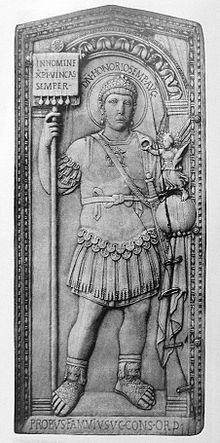
The emperor
Honorius
holding a variant of the
labarum – the Latin phrase on the cloth means “In the name of Christ
[rendered by the Greek letters XPI] be ever victorious.”
Among a number of standards depicted on the
Arch of Constantine
, which was erected, largely
with fragments from older monuments, just three years after the battle, the
labarum does not appear. A grand opportunity for just the kind of political
propaganda that the Arch otherwise was expressly built to present was missed.
That is if Eusebius’ oath-confirmed account of Constantine’s sudden,
vision-induced, conversion can be trusted. Many historians have argued that in
the early years after the battle the emperor had not yet decided to give clear
public support to Christianity, whether from a lack of personal faith or because
of fear of religious friction. The arch’s inscription does say that the Emperor
had saved the
res publica
INSTINCTV DIVINITATIS
MENTIS MAGNITVDINE (“by greatness of mind and by instinct [or impulse]
of divinity”). As with his predecessors, sun symbolism – interpreted as
representing
Sol Invictus
(the Unconquered Sun) or
Helios
,
Apollo
or
Mithras
– is inscribed on his coinage, but in
325 and thereafter the coinage ceases to be explicitly pagan, and Sol Invictus
disappears. In his
Historia Ecclesiae
Eusebius further reports
that, after his victorious entry into Rome, Constantine had a statue of himself
erected, “holding the sign of the Savior [the cross] in his right hand.” There
are no other reports to confirm such a monument.
Whether Constantine was the first
Christian
emperor supporting a peaceful
transition to Christianity during his rule, or an undecided pagan believer until
middle age, strongly influenced in his political-religious decisions by his
Christian mother
St. Helena
, is still in dispute among
historians.
As for the labarum itself, there is little evidence for its use before 317.In
the course of Constantine’s second war against Licinius in 324, the latter
developed a superstitious dread of Constantine’s standard. During the attack of
Constantine’s troops at the
Battle of Adrianople
the guard of the labarum
standard were directed to move it to any part of the field where his soldiers
seemed to be faltering. The appearance of this talismanic object appeared to
embolden Constantine’s troops and dismay those of Licinius.At the final battle
of the war, the
Battle of Chrysopolis
, Licinius, though
prominently displaying the images of Rome’s pagan pantheon on his own battle
line, forbade his troops from actively attacking the labarum, or even looking at
it directly.[16]
Constantine felt that both Licinius and
Arius
were agents of Satan, and associated them
with the serpent described in the
Book of Revelation
(12:9).
Constantine represented Licinius as a snake on his coins.
Eusebius stated that in addition to the singular labarum of Constantine,
other similar standards (labara) were issued to the Roman army. This is
confirmed by the two labara depicted being held by a soldier on a coin of
Vetranio
(illustrated) dating from 350.
Later usage

Modern ecclesiastical labara (Southern Germany).

The emperor
Constantine Monomachos
(centre
panel of a Byzantine enamelled crown) holding a miniature labarum
The Chi Rho is one of the earliest
christograms
used by Christians. It is formed by superimposing the
first two letters in the Greek spelling of the word
Christ
(
Greek
: “Χριστός” ), chi = ch and rho = r, in such a way to produce
the monogram
☧. The Chi-Rho symbol was also used by pagan Greek scribes to
mark, in the margin, a particularly valuable or relevant passage; the
combined
letters Chi and Rho standing for chrēston, meaning “good.”
Although not technically a cross, the Chi Rho invokes the crucifixion
of Jesus as well as symbolizing his status as the Christ. There is early
evidence of the Chi Rho symbol on Christian Rings of the third century.
The labarum (Greek:
λάβαρον) was a
vexillum
(military standard) that displayed the “Chi-Rho”
symbol, formed from the first two
Greek letters
of the word “Christ”
(Greek:
ΧΡΙΣΤΟΣ, or Χριστός) — Chi (χ)
and Rho (ρ).
It was first used by the
Roman emperor
Constantine I
. Since the vexillum consisted of a flag suspended from
the crossbar of a cross, it was ideally suited to symbolize
crucifixion
. The Chi-Rho symbol was also used by Greek scribes to
mark, in the margin, a particularly valuable or relevant passage; the
combined letters Chi and Rho standing for chrēston, meaning
“good.”
Saint George (ca. 275/281 – 23 April 303) was, according to tradition,
a Roman soldier and a priest in the Guard
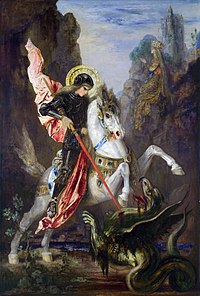
of
Diocletian
, who is venerated as a
Christian
martyr
. In
hagiography
Saint George is one of the most
venerated saints in the
Catholic
(Western
and
Eastern Rites
),
Anglican
,
Eastern Orthodox
, and the
Oriental Orthodox
churches. He is immortalized
in the tale of
Saint George and the Dragon
and is one of the
Fourteen Holy Helpers
. His memorial is
celebrated on 23 April, and he is regarded as one of the most prominent
military saints
.
Many
Patronages of Saint George
exist around the
world, including: Aragon
,
Catalonia
,
England
,
Ethiopia
,
Georgia
,
Greece
,
Iraq,
Lithuania
,
Palestine
,
Portugal
,
Serbia
and
Russia
, as well as the cities of
Genoa
,
Amersfoort
,
Beirut
,
Fakiha
,
Bteghrine
,
Cáceres
,
Ferrara
,
Freiburg
,
Ljubljana
,
Pomorie
,
Preston
,
Qormi
,
Rio de Janeiro
,
Lod,
Barcelona
,
Moscow
,
Tamworth
and the
Maltese
island of
Gozo, as well as a wide range of professions, organizations and
disease sufferers.
Saint George (c. 275/281 – 23 April 303 AD) was a Greek who became an
officer in the Roman army. His father was the Greek Gerondios from
Cappadocia
Asia Minor and his mother was from
the city Lydda
.
Lydda
was a Greek city in
Palestine
from the times of the conquest of
Alexander the Great (333 BC). Saint George became an officer in the Roman army
in the Guard of
Diocletian
. He is venerated as a Christian
martyr. In
hagiography
, Saint George is one of the most
venerated saints in the
Catholic
(Western
and
Eastern Rites
),
Anglican
,
Eastern Orthodox
, and the
Oriental Orthodox
churches. He is immortalized
in the tale of
Saint George and the Dragon
and is one of the
Fourteen Holy Helpers
. His memorial is
celebrated on 23 April, and he is regarded as one of the most prominent
military saints
.
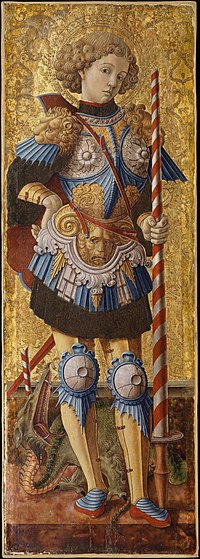
Many
Patronages of Saint George
exist around the
world, including:
Georgia
,
England
,
Egypt
,
Bulgaria
,
Aragon
,
Catalonia
,
Romania
,
Ethiopia
,
Greece
,
India
,
Iraq, Israel
,
Lebanon
,
Lithuania
,
Palestine
,
Portugal
,
Serbia
,
Ukraine
and
Russia
, as well as the cities of
Genoa
,
Amersfoort
,
Beirut
,
Botoşani
,
Drobeta Turnu-Severin
,
Timişoara
,
Fakiha
,
Bteghrine
,
Cáceres
,
Ferrara
,
Freiburg im Breisgau
,
Kragujevac
,
Kumanovo
,
Ljubljana
,
Pérouges
,
Pomorie
,
Preston
,
Qormi
,
Rio de Janeiro
,
Lod,
Lviv,
Barcelona
,
Moscow
and
Victoria, as well as of
the Scout Movement
[3]
and a wide range of professions, organizations and disease sufferers.
Life of Saint George
Historians have argued the exact details of the birth of Saint George for
over a century, although the approximate date of his death is subject to little
debate.[4][5]
The 1913
Catholic Encyclopedia
takes the position that
there seems to be no ground for doubting the historical existence of Saint
George, but that little faith can be placed in some of the fanciful stories
about him.[6]
The work of the
Bollandists
Danile Paperbroch
,
Jean Bolland
and
Godfrey Henschen
in the 17th century was one of
the first pieces of scholarly research to establish the historicity of the
saint’s existence via their publications in
Bibliotheca Hagiographica Graeca
and paved the
way for other scholars to dismiss the medieval legends.[7][8]
Pope Gelasius
stated that George was among
those saints “whose names are justly reverenced among men, but whose actions are
known only to God.”[9]
The traditional legends
have offered a historicised narration
of George’s encounter with a
dragon
: see “St. George and the Dragon” below.
The modern legend that follows below is synthesised from early and late
hagiographical sources
, omitting the more
fantastical episodes, to narrate a purely human military career in closer
harmony with modern expectations of reality. Chief among the legendary sources
about the saint is the
Golden Legend
, which remains the most familiar
version in English owing to
William Caxton
‘s 15th-century translation.[10]
It is likely that Saint George was born to a Greek Christian noble family in
Lydda, Palestine, during the late third century between about 275 AD and 285 AD,
and he died in the Greek city Nicomedia, Asia Minor. His father, Gerontios, was
a Greek, from Cappadocia, Asia Minor, officer in the Roman army and his mother,
Polychronia, was a Greek from the city Lydda, Palestine. They were both
Christians and from noble families of
Anici
, so the child was raised with Christian
beliefs. They decided to call him Georgios (Greek), meaning “worker of the land”
(i.e., farmer). At the age of 14, George lost his father; a few years later,
George’s mother, Polychronia, died.[11][12][13][14]
Eastern accounts give the names of his parents as Anastasius and Theobaste.[citation
needed]

Saint George Killing the Dragon, 1434/35, by
Martorell
Then George decided to go to
Nicomedia
, the imperial city of that time, and
present himself to Emperor
Diocletian
to apply for a career as a soldier.
Diocletian welcomed him with open arms, as he had known his father, Gerontius —
one of his finest soldiers. By his late 20s, George was promoted to the rank of
Tribunus
and stationed as an imperial guard of
the Emperor at Nicomedia.[15]
In the year AD 302, Diocletian (influenced by
Galerius
) issued an edict that every Christian
soldier in the army should be arrested and every other soldier should offer a
sacrifice to the
Roman gods
of the time. However George objected
and with the courage of his faith approached the Emperor and ruler. Diocletian
was upset, not wanting to lose his best
tribune
and the son of his best official,
Gerontius. George loudly renounced the Emperor’s edict, and in front of his
fellow soldiers and Tribunes he claimed himself to be a Christian and declared
his worship of Jesus Christ. Diocletian attempted to convert George, even
offering gifts of land, money and slaves if he made a sacrifice to the Roman
gods. The Emperor made many offers, but George never accepted.[16]
Recognizing the futility of his efforts, Diocletian was left with no choice
but to have him executed for his refusal. Before the execution George gave his
wealth to the poor and prepared himself. After various torture sessions,
including laceration on a wheel of swords in which he was resuscitated three
times, George was executed by
decapitation
before Nicomedia’s city wall, on
April 23, 303. A witness of his suffering convinced Empress Alexandra and
Athanasius, a pagan priest, to become Christians as well, and so they joined
George in martyrdom. His body was returned to
Lydda
in Palestine for burial, where Christians
soon came to honour him as a martyr.[17][18]:166
Although the above distillation of the legend of George connects him to the
conversion of Athanasius, who according to
Rufinus
was brought up by Christian
ecclesiastical authorities from a very early age,[19]
Edward Gibbon
[20][21]
argued that George, or at least the legend from which the above is distilled, is
based on
George of Cappadocia
,[22][23]
a notorious Arian bishop who was Athanasius’ most bitter rival, who in time
became Saint George of England. According to Professor Bury, Gibbon’s latest
editor, “this theory of Gibbon’s has nothing to be said for it.” He adds that:
“the connection of St. George with a dragon-slaying legend does not relegate him
to the region of the myth”.[24]
In 1856
Ralph Waldo Emerson
published a book of essays
entitled “English Traits.” In it, he wrote a paragraph on the history of Saint
George. Emerson compared the legend of Saint George to the legend of
Amerigo Vespucci
, calling the former “an
impostor” and the latter “a thief.”[25][26]
The editorial notes appended to the 1904 edition of Emerson’s complete works
state that Emerson based his account on the work of Gibbon, and that current
evidence seems to show that real St. George was not George the Arian of
Cappadocia.[25]
Merton M. Sealts also quotes
Edward Emerson
, Ralph Waldo Emerson’s youngest
son as stating that he believed his father’s account was derived from Gibbon and
that the real St. George “was apparently another who died two generations
earlier.”[27]
Saint George and
the dragon
Eastern Orthodox depictions of Saint George slaying a dragon often include
the image of the young maiden who looks on from a distance. The standard
iconographic interpretation of the image
icon is that the dragon represents both Satan (Rev. 12:9) and the
Roman Empire. The young maiden is the wife of
Diocletian
,
Alexandra
. Thus, the image as interpreted
through the language of Byzantine iconography, is an image of the martyrdom of
the saint.[citation
needed]
The episode of St. George and the
Dragon
was a legend[28]
brought back with the
Crusaders
and retold with the courtly
appurtenances belonging to the
genre of Romance
. The earliest known depiction
of the legend is from early eleventh-century
Cappadocia
(in the
iconography
of the
Eastern Orthodox Church
, George had been
depicted as a soldier
since at least the seventh century);
the earliest known surviving narrative text is an eleventh-century Georgian
text.

White George on the
coat of arms
of
Georgia
.
In the fully developed Western version, which developed as part of the
Golden Legend
, a dragon or
crocodile
makes its nest at the
spring
that provides water for the city of “Silene”
(perhaps modern
Cyrene
in
Libya
or the city of
Lydda in the
Holy Land
, depending on the source).
Consequently, the citizens have to dislodge the dragon from its nest for a time,
to collect water. To do so, each day they offer the dragon at first a sheep, and
if no sheep can be found, then a
maiden
must go instead of the sheep. The victim
is chosen by drawing lots. One day, this happens to be the
princess
. The
monarch
begs for her life to be spared, but to
no avail. She is offered to the dragon, but there appears Saint George on his
travels. He faces the dragon, protects himself with the
sign of the Cross
,[29]
slays the dragon, and rescues the princess. The citizens abandon their ancestral
paganism
and convert to Christianity.
The dragon motif was first combined with the standardised Passio Georgii
in
Vincent of Beauvais
‘ encyclopaedic Speculum
Historiale and then in
Jacobus de Voragine
‘s “Golden
Legend“, which guaranteed its popularity in the later
Middle Ages
as a literary and pictorial
subject.
The parallels with
Perseus
and
Andromeda
are inescapable. In the
allegorical
reading, the dragon embodies a
suppressed
pagan cult
.[30]
The story has other roots that predate Christianity. Examples such as
Sabazios
, the
sky father
, who was usually depicted riding on
horseback, and Zeus
‘s defeat of
Typhon
the
Titan
in
Greek mythology
, along with examples from
Germanic
and
Vedic traditions
, have led a number of
historians, such as Loomis, to suggest that George is a
Christianized
version of older deities in
Indo-European culture.
In the medieval romances, the lance with which St George slew the dragon was
called Ascalon, named after the city of
Ashkelon
in the
Levant
.[31]
Veneration as a martyr
A church built in Lydda
during the reign of
Constantine I
(reigned 306–37), was consecrated
to “a man of the highest distinction”, according to the church history of
Eusebius of Caesarea
; the name of the patron[32]
was not disclosed, but later he was asserted to have been George.
By the time of the Muslim conquest in the seventh century, a basilica
dedicated to the saint in Lydda existed.[33]
The church was destroyed in 1010 but was later rebuilt and dedicated to Saint
George by the
Crusaders
. In 1191 and during the conflict
known as the
Third Crusade
(1189–92), the church was again
destroyed by the forces of
Saladin
, Sultan of the
Ayyubid dynasty
(reigned 1171–93). A new church
was erected in 1872 and is still standing.
During the fourth century the veneration of George spread from Palestine
through Lebanon to the rest of the
Eastern Roman Empire
– though the martyr is not
mentioned in the Syriac
Breviarium
[18]
– and
Georgia
. In Georgia the feast day on November
23 is credited to
St Nino
of
Cappadocia
, who in Georgian hagiography is a
relative of St George, credited with bringing Christianity to the Georgians in
the fourth century. By the fifth century, the
cult
of Saint George had reached the
Western Roman Empire
as well: in 494, George
was canonized as a saint
by
Pope Gelasius I
, among those “whose names are
justly reverenced among men, but whose acts are known only to [God].”
In England the earliest dedication to George, who was mentioned among the
martyrs by Bede
, is a church at
Fordington
, Dorset, that is mentioned in the
wars of
Alfred the Great
. He did not rise to the
position of “patron saint”, however, until the 14th century, and he was still
obscured by
Edward the Confessor
, the traditional patron
saint of England, until 1552 when all saints’ banners other than George’s were
abolished in the
English Reformation
.
[34]
An apparition of George heartened the Franks at the
siege of Antioch
, 1098, and made a similar
appearance the following year at Jerusalem. Chivalric military
Order of St. George
were established in
Aragon
(1201),
Genoa
,
Hungary
, and by
Frederick III, Holy Roman Emperor
,[35]
and in England the Synod of Oxford, 1222 declared
St George’s Day
a feast day in the kingdom of
England.
Edward III
put his
Order of the Garter
under the banner of St.
George, probably in 1348. The chronicler
Froissart
observed the English invoking St.
George as a battle cry on several occasions during the
Hundred Years’ War
. In his rise as a national
saint George was aided by the very fact that the saint had no legendary
connection with England, and no specifically localized shrine, as of
Thomas Becket
at Canterbury: “Consequently,
numerous shrines were established during the late fifteenth century,” Muriel C.
McClendon has written,[36]
“and his did not become closely identified with a particular occupation or with
the cure of a specific malady.”
The establishment of George as a popular saint and protective giant[37]
in the West that had captured the medieval imagination was codified by the
official elevation of his feast to a festum duplex[38]
at a church council in 1415, on the date that had become associated with his
martyrdom, 23 April. There was wide latitude from community to community in
celebration of the day across late medieval and early modern England,[39]
and no uniform “national” celebration elsewhere, a token of the popular and
vernacular nature of George’s cultus and its local horizons, supported by
a local guild
or confraternity under George’s
protection, or the dedication of a local church. When the Reformation in England
severely curtailed the saints’ days in the calendar, St. George’s Day was among
the holidays that continued to be observed.
Sources

The
coat of arms
of
Volodymyr
is the oldest known
Ukrainian city emblem.
According to the
Catholic Encyclopedia
, the earliest text
preserving fragments of George’s narrative is in an
Acta Sanctorum
identified by
Hippolyte Delehaye
of the scholarly
Bollandists
to be a
palimpsest
of the fifth century. However, this
Acta Sancti Georgii was soon banned as
heresy
by
Pope Gelasius I
(in 496).
The compiler of this Acta, according to Hippolyte Delehaye “confused
the martyr with his namesake, the celebrated
George of Cappadocia
, the
Arian
intruder into the see of Alexandria and
enemy of St.
Athanasius
“. A critical edition of a Syriac
Acta of Saint George, accompanied by an annotated English translation was
published by E.W. Brooks (1863–1955) in 1925. The hagiography was originally
written in Greek.
In Sweden, the princess rescued by Saint George is held to represent the
kingdom of Sweden, while the dragon represents an invading army. Several
sculptures of Saint George battling the dragon can be found in Stockholm, the
earliest inside Storkyrkan (“The Great Church”) in the Old Town.
The façade of architect
Antoni Gaudi
‘s famous
Casa Batlló
in
Barcelona, Spain
depicts this allegory.
In Islamic cultures
Saint George is somewhat of an exception among saints and legends, in that he
is known and respected by
Muslims
, as well as venerated by Christians
throughout the
Middle East
, from Egypt to Asia Minor.[40]
His stature in these regions derives from the fact that his figure has become
somewhat of a composite character mixing elements from Biblical, Quranic and
folkloric sources, at times being partially identified with
Al-Khidr
.[40]
He is said to have killed a dragon near the sea in
Beirut
and at the beginning of the 20th century
Muslim women used to visit his shrine in the area to pray for him.[40]
Feast days
In the General Calendar of the
Roman Rite
the feast of Saint George is on
April 23. In the
Tridentine Calendar
it was given the rank of “Semidouble”.
In Pope Pius XII
‘s
1955 calendar
this rank is reduced to “Simple”.
In
Pope John XXIII
‘s
1960 calendar
the celebration is further
demoted to just a
“Commemoration”
. In
Pope Paul VI
‘s
1969 calendar
it is raised to the level of an
optional “Memorial”. In some countries, such as
England
, the rank is higher.
St George is very much honoured by the
Eastern Orthodox Church
, wherein he is referred
to as a “Great Martyr”, and in
Oriental Orthodoxy
overall. His major
feast day
is on April 23 (Julian
Calendar April 23 currently corresponds to
Gregorian Calendar
May 6). If, however, the
feast occurs before Easter
, it is celebrated on
Easter Monday
instead. The
Russian Orthodox Church
also celebrates two
additional feasts in honour of St. George: one on November 3 commemorating the
consecration
of a
cathedral
dedicated to him in
Lydda during the reign
Constantine the Great
(305–37). When the church
was consecrated, the relics
of the St. George were transferred
there. The other feast on November 26 for a church dedicated to him in
Kiev, ca. 1054.
In Egypt
the
Coptic Orthodox Church of Alexandria
refers to
St George as the “Prince of Martyrs” and celebrates his martyrdom on the 23rd of
Paremhat
of the
Coptic Calendar
equivalent to May 1. The
Copts
also celebrate the
consecration
of the first church dedicated to
him on 7th of the month of Hatour of the Coptic Calender usually equivalent to
17 November.
Patronages
A highly celebrated saint in both the
Western
and
Eastern
Christian
churches, a large number of
Patronages of Saint George
exist throughout the
world.[41]
St. George is the patron saint of England. His cross forms the national
flag of England
, and features within the
Union Flag
of the
United Kingdom
, and other national flags
containing the Union Flag, such as those of
Australia
and
New Zealand
. Traces of the cult of Saint George
in England pre-date the
Norman Conquest
in the eleventh century;[citation
needed] by the fourteenth century the saint had been
declared both the patron saint and the protector of the royal family.[42]

St George’s monument in
Tbilisi
,
Georgia
.
The
country of Georgia
, where devotions to the
saint date back to the fourth century, is not technically named after the saint,
but is a well-attested
backward derivation
of the English name.
However, a large number of towns and cities around the world are. Saint George
is one of the patron Saints of Georgia; the name Georgia (Sakartvelo in
Georgian) is an anglicisation
of Gurj, derived from the
Persian
word for the frightening and heroic
people in that territory.[43]
However, chronicles describing the land as Georgie or Georgia in French
and English, date from the early Middle Ages “because of their special reverence
for Saint George”,[44]
but these accounts have been seen as
folk etymology
;[citation
needed] compare
Land of Prester John
.
There are exactly 365 Orthodox churches in
Georgia
named after Saint George according to
the number of days in a year. According to myth, St. George was cut into 365
pieces after he fell in battle and every single piece was spread throughout the
entire country.[45][46][47]
According to another myth, Saint George appeared in person during the
Battle of Didgori
to support the Georgian
victory over the
Seldjuk army
and the Georgian uprising against
Persian rule. Saint George is considered by many Georgians to have special
meaning as a symbol of national liberation.[48]
Devotions to Saint George in
Portugal
date back to the twelfth century, and
Saint Constable
attributed the victory of the
Portuguese in the
battle of Aljubarrota
in the fourteenth century
to Saint George. During the reign of King
John I
(1357–1433) Saint George became the
patron saint of Portugal and the King ordered that the saint’s image on the
horse be carried in the
Corpus Christi
procession. In fact, the
Portuguese Army motto means Portugal and Saint George, in perils and in efforts
of war.[49]
Saint George is also one of the patron saints of the Mediterranean islands of
Malta
and
Gozo. In a battle between the Maltese and the Moors, Saint George was
alleged to have been seen with Saint Paul and Saint Agata, protecting the
Maltese. Besides being the patron of Victoria where
St. George’s Basilica, Malta
is dedicated to
him, St George is the protector of the island Gozo.[50]
Interfaith Shrine
There is a tradition in the Holy Land of Christians and Muslim going to an
Eastern Orthodox
shrine of St. George at
Beith Jala
, Jews also attend the site in the
belief that the prophet
Elijah
was buried there. This is testified to
by
Elizabeth Finn
in 1866, where she wrote, “St.
George killed the dragon in this country
Palestine
; and the place is shown close to
Beirut
(Lebanon).
Many churches and convents are named after him. The church at
Lydda is dedicated to St. George: so is a convent near Bethlehem, and
another small one just opposite the Jaffa gate; and others beside. The Arabs
believe that St. George can restore mad people to their senses; and to say a
person has been sent to St. George’s, is equivalent to saying he has been sent
to a madhouse. It is singular that the Moslem Arabs share this veneration for
St. George, and send their mad people to be cured by him, as well as the
Christians. But they commonly call him
El Khudder
—The Green—according to their
favourite manner of using epithets instead of names. Why he should be called
green, however, I cannot tell—unless it is from the colour of his horse. Gray
horses are called green in Arabic.”[51]
A possible explanation for this colour reference is
Al Khidr
, the erstwhile tutor of Moses, gained
his name from having sat in a barren desert, turning it into a lush green
paradise.[52][53]
William Dalrymple
reviewing the literature in
1999 tells us that
J. E. Hanauer
in his 1907 book Folklore of
the Holy Land: Muslim, Christian and Jewish “mentioned a shrine in the
village of Beit Jala, beside Bethlehem, which at the time was frequented by all
three of Palestine’s religious communities. Christians regarded it as the
birthplace of St. George, Jews as the burial place of the Prophet Elias.
According to Hanauer, in his day the monastery was “a sort of madhouse. Deranged
persons of all the three faiths are taken thither and chained in the court of
the chapel, where they are kept for forty days on bread and water, the
Eastern Orthodox
priest at the head of the
establishment now and then reading the Gospel over them, or administering a
whipping as the case demands.’[54]
In the 1920s, according to
Taufiq Canaan
‘s Mohammedan Saints and
Sanctuaries in Palestine, nothing seemed to have changed, and all three
communities were still visiting the shrine and praying together.”[55]
|





 of the 12th century who reigned over a crucial turning
of the 12th century who reigned over a crucial turning 












